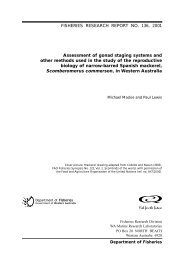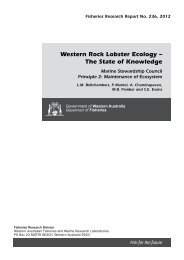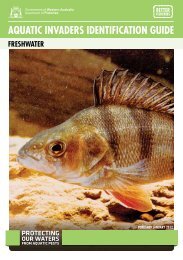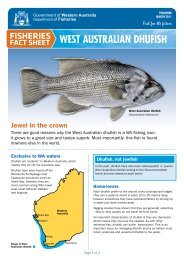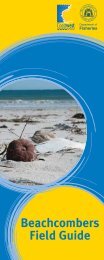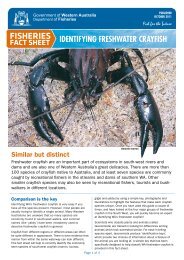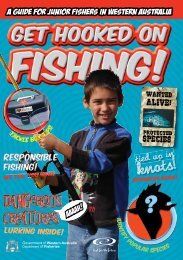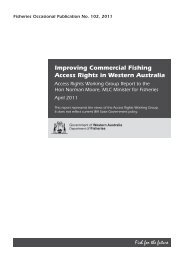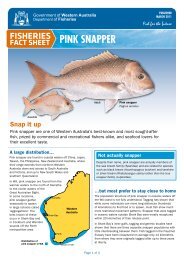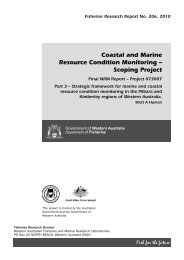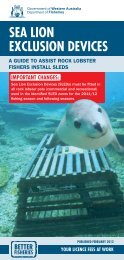DEPARTMENT OF FISHERIES ANNUAL REPORT TO THE ...
DEPARTMENT OF FISHERIES ANNUAL REPORT TO THE ...
DEPARTMENT OF FISHERIES ANNUAL REPORT TO THE ...
Create successful ePaper yourself
Turn your PDF publications into a flip-book with our unique Google optimized e-Paper software.
SUMMARy <strong>OF</strong> <strong>THE</strong> yEAR � FROM <strong>THE</strong> CHIEF ExECUTIvE <strong>OF</strong>FICER<br />
International Union for the Conservation of<br />
Nature (IUCN) criteria for classification as marine<br />
protected areas under the Conservation and Land<br />
Management Act 1984 and the Fish Resources<br />
Management Act 1994. In State waters additional<br />
marine reserves are being planned for the<br />
Kimberley and in the South West ‘Capes’ area. At<br />
the same time the Commonwealth is in the process<br />
of implementing a system of marine reserves<br />
beyond the State three-nautical-mile-limit in waters<br />
stretching from the Northern Territory to the South<br />
Australian border.<br />
A very strong Leeuwin Current and unusually<br />
high water temperatures – in some places the<br />
highest-ever recorded – contributed to a number<br />
of marine ‘fish kills’ over the 2010/11 summer,<br />
with abalone deaths reported near the Greenough<br />
River mouth and in the waters north of Kalbarri.<br />
Fish kills were also recorded in Jurien Bay and<br />
Leeman and coral bleaching was observed at the<br />
Abrolhos Islands. The strength of the Leeuwin<br />
Current also saw many tropical species extend<br />
their range as far south as Albany over the<br />
summer months.<br />
To help us better understand the likely<br />
causes and significance of this unusual event the<br />
Department convened a workshop of more than 80<br />
marine scientists and managers from organisations<br />
including the Department of Environment and<br />
Conservation, the CSIRO, the Australian Institute of<br />
Marine Science and the Department of Fisheries.<br />
In addition, a joint Department of Fisheries/CSIRO<br />
project to closely examine climate change effects<br />
on Western Australia’s marine environment was<br />
commenced.<br />
Implementation of a new fee-setting model<br />
applying a royalty-like access fee of 5.75 per cent<br />
of the gross value of production (GVP) for each<br />
commercial fishery commenced on 1 July 2010.<br />
This new approach removes the inequity evident<br />
under the old model where some licence fees were<br />
as high as 20 per cent of the GVP of the fishery,<br />
while others were as low as one per cent.<br />
Importantly, the new model moves away from<br />
cost recovery, where the bulk of the Department’s<br />
revenue was tied to the level of service provision<br />
in the State’s major fisheries – West Coast Rock<br />
Lobster, Shark Bay Scallop, Shark Bay Prawn,<br />
Exmouth Gulf Prawn, pearling and, to a lesser<br />
extent, abalone – with limited funding available to<br />
address sustainability issues of other fisheries.<br />
In future, all revenue raised through<br />
commercial access fees will be able to be directed<br />
to commercial fisheries research, management<br />
and compliance projects of the greatest need,<br />
with the exception of funds allocated to the<br />
Commonwealth’s Fisheries Research and<br />
Development Corporation (0.25 per cent of GVP)<br />
for fisheries research and to the WA Fishing<br />
Industry Council (0.5 per cent of GVP).<br />
In 2010/11 the commercial fishing industry<br />
contributed $19.8 million in access fees.<br />
6



